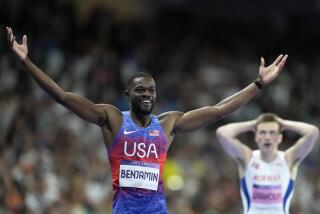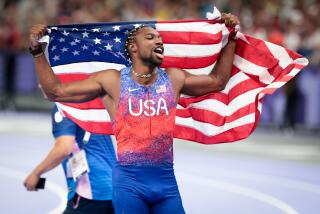He Easily Hurdles the Field
- Share via
Quick now, what was the Big--with a capital B --sports story of 1992?
The Washington Redskins’ Super Bowl victory?
Naw. There’s a Super Bowl victory every year.
The Toronto Blue Jays winning the World Series?
Nah. There’s a World Series winner every year.
How about Riddick Bowe becoming the heavyweight champion?
Be serious. We’re up to our hips in heavyweight champs--WBCs, WBAs, IBFs--we have a heavyweight champ for every letter of the alphabet.
No, the single biggest achievement in sports in the Year of Our Lord 1992 was put up by Kevin Young.
If you say, “Who!?” you are in not necessarily good company but in numerous company. But Track & Field News is not fooled. It goes right past Dream Teams, pennants, bowl games; past the pugilists, tennis players, race drivers and goalies, and settles on Kevin Young as its men’s athlete of the year. Period. The subject is not even up for discussion.
First of all, Young won an Olympic gold medal. This may be the most prestigious bauble in sport. You cannot win one every year, you can win one only every four.
Secondly, he broke a world record in his event. It was the only individual world record broken in the Olympics in track and field.
Plus, it wasn’t merely any record. It was a record that had not been broken in almost 10 years; it was a record that had held since 1983, and it was the longest-standing record in the sport of track this side of Pietro Mennea’s 1979 mark in the 200 meters.
It broke a mark that had been considered almost as unattainable as the 4-minute mile once was--the under-47-seconds 400-meter hurdles. Not even the great Edwin Moses could cross that barrier. The great Edwin had won 107 consecutive races, but his all-time best had stalled at 47.02 for a decade.
Young ran 46.78--and finished waving his arms excitedly in the air, costing him, perhaps, a faster mark. Young’s race broke the Olympic record by 4/10ths of a second. He won his race by seven yards. This is like winning Indy by three laps, Wimbledon at love, the Open by 10 shots, or a title fight by one-round knockout. The 400-meter hurdle races usually finish like dinner call in a boardinghouse or a bustout at jail. It takes a picture to find a winner.
The 1988 finish found Andre Phillips beating Amadou Dia Ba by four- hundredthse of a second.
Hurdling is a special discipline, part sheer speed, part technique, which came so slowly to Kevin Young that he was not even a scholarship athlete but a walk-on his first years at UCLA. He had tinkered with the high jump, the long jump and the triple jump in high school, but when he got to UCLA, it was evident to his coach there, John Smith, a former Olympian himself, that God intended Young to be a quarter-miler and a hurdler.
First of all, there were those long legs. Young is 6 feet 4, and about 5-2 of it is legs. He has an inseam of 37 inches, which means he can’t buy his slacks off the rack like the rest of us but must take his case to a tailor.
This also means he looks as if he could take the hurdles two at a time and he often needs only 12 strides between each of the 10 hurdles, whereas the average hurdler requires 13 or more.
His high jump training made the three-foot-high hurdles as easy as stepping over a crack in the sidewalk. That was the trouble. He was topping the timber like a guy trying to clear a parked car. By the time he came down, the field had gone by.
Of course, clearing hurdles was an old story to young Mr. Young. Raised in Watts, he never did have a clear track ahead. But he kept his eye so resolutely on the finish line in life that he got over every hurdle the boys in the ‘hood could tempt him with. He not only became a dedicated track athlete, he became student-body president at Jordan High.
He got to UCLA by pasting together Coca-Cola scholarships and academic scholarships. He couldn’t get an athletic scholarship but when he showed up, uninvited, for the track tryouts, Smith had to wipe the drool off his chin. “Lemme have him!” he remembers thinking excitedly. He turned him into a hurdler. It was like giving Willie Mays a bat. “Within a year, he’s winning the conference championship and ranks 10th in the world,” Smith recalls.
Young was born to hurdle. So are a lot of people. Being born to work is another matter. Runners are born, not made, but hurdling is blue-collar work.
Young shuffled from weight room to training track and made the ’88 Olympic team. He finished fourth at Seoul, struggling behind the third-place Moses. He found that, at about 300 meters, he began to run on empty. His fuel was gone. He had his private wall of pain. Marathoners hit it at 20 miles. Kevin hit it at the seventh hurdle. Sometimes, he hit the hurdle, too.
But finishing fourth running on fumes buoyed him to a point where he remembers telling himself, “Hey, I’m fourth-best in the whole world!”
He worked on his stamina. But it was not till he ran third to the crack Zambian hurdler, Samuel Matete, that his ambitions began to swell. Matete had run a blistering 47.10, the second-fastest in history. But Young was encouraged. “I thought, ‘Hey! I can do something here!’ ” he recalls telling himself.
He began to beat Matete. And everybody else. He began to carry cards around with “46.89” on them. He wrote the figure on his mirror in Barcelona.
For a man who had never run faster than 47.72, this seemed the wildest kind of optimism.
Actually, he underestimated himself. At Barcelona, he ran 11/100ths faster than he dreamed he could.
Young, who will run the 500 in this year’s Sunkist Invitational at the Sports Arena on Feb. 20, paled every touchdown pass, knockout punch, bases-loaded homer, and pulled off the sports feat of the year. Does he now want to set out after Moses’ consecutive-victory streak? Young shakes his head: “I would like to keep breaking the record. I would like to see it read, “Young, 46.70; Young, 46.50; Young, 46.40.”
Maybe he should simply paint “45.89” on the wall.
More to Read
Go beyond the scoreboard
Get the latest on L.A.'s teams in the daily Sports Report newsletter.
You may occasionally receive promotional content from the Los Angeles Times.










